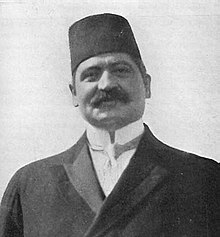Ambassador Morgenthau's Story
Doubleday, Page | |
Publication date | 1918 |
|---|---|
| Media type | Print (Hardcover) |
| Pages | 407 pages |
Ambassador Morgenthau's Story (1918) is the title of the published memoirs of
The book is a primary source regarding the
Contents
The former U.S. Ambassador to the
On the Defense of Van
Morgenthau reported from the Ottoman cities of Aleppo and Van. He quoted the testimonies of the consulate officials who justified the deportations as necessary and who also suggested a supposed complicity of the Armenian population of Van with the incoming Russian forces that had overtaken the city, a pretext they used as a justification for the persecution of all ethnic Armenians.
In his memoirs, Morgenthau later wrote that:
When the Turkish authorities gave the orders for these deportations, they were merely giving the death warrant to a whole race; they understood this well, and, in their conversations with me, they made no particular attempt to conceal the fact.
Discussions with Ottoman leaders

It took some time before the story of the Armenian atrocities reached the U.S. Embassy with all its details. Ambassador Morgenthau subsequently raised the issue in person with Talaat Pasha and Enver Pasha. When Morgenthau asked both whether the information reaching the embassy was reliable, they regarded it as a mere manifestation of the disorders that had prevailed inside the Armenian provinces for many years. When the consular reports came from Van and Urfa, both Enver and Talaat Pasha dismissed them as wild exaggerations.
The ambassador asked the U.S. Government to intervene, but the United States was not a participant in the World War I at the time and could only have made written or verbal protests to the Ottoman authorities. This was not done and Morgenthau was left without leverage beyond his personal rapport with those in power; when that failed too, he then drew international media attention to the ongoing Armenian genocide, organized private relief efforts and helped create the American Committee for Armenian and Syrian Relief (ACASR).
Reception
According to
Gallery
Photographs contained in the memoirs include:
-
Mehmet Talat Pasha and Richard von Kühlmann
-
Caption from the book: "THOSE WHO FELL BY THE WAYSIDE. Scenes like this were common all over the Armenian provinces, in the spring and summer months of 1915. Death in its several forms---massacre, starvation, exhaustion---destroyed the larger part of the refugees. The Turkish policy was that of extermination under the guise of deportation"
Editions
- Morgenthau, Henry (1918). Ambassador Morgenthau's Story. Doubleday, Page& Co.
- Original republished in 2003 by the ISBN 978-1909382213.
- Republished by ISBN 978-0814329795.
- Original republished in 2003 by the
Further reading
- Morgenthau, Henry (2004). United States Diplomacy on the Bosphorus: The Diaries of Ambassador Morgenthau, 1913-1916. Compiled with an introduction by Ara Sarafian. London: Taderon Press (Gomidas Institute). ISBN 978-1903656402.
- ISBN 978-1909382268.
Notes
- ^ Morgenthau, Henry (1919). Ambassador Morgenthau's Story (1 ed.). Garden City, New York: Doubleday, Page & Company. Retrieved June 23, 2016 – via Internet Archive.
- ^ a b Ambassador Morgenthau's Story. 1918. Chapter Twenty-Seven
- ISBN 978-0-19-935069-8.
External links
 The full text of Ambassador Morgenthau's Story at Wikisource
The full text of Ambassador Morgenthau's Story at Wikisource- Ambassador Morgenthau's Story - online edition
- Henry Morgenthau. Ambassador Morgenthau's Story at Project Gutenberg
 Ambassador Morgenthau's Story public domain audiobook at LibriVox
Ambassador Morgenthau's Story public domain audiobook at LibriVox




![Caption from the book: A RELIC OF THE ARMENIAN MASSACRES AT ERZINGAN. Such mementos are found all over Armenia".[2]](http://upload.wikimedia.org/wikipedia/commons/thumb/4/45/Ambassador_Morgenthau%27s_Story_p435b.jpg/120px-Ambassador_Morgenthau%27s_Story_p435b.jpg)

